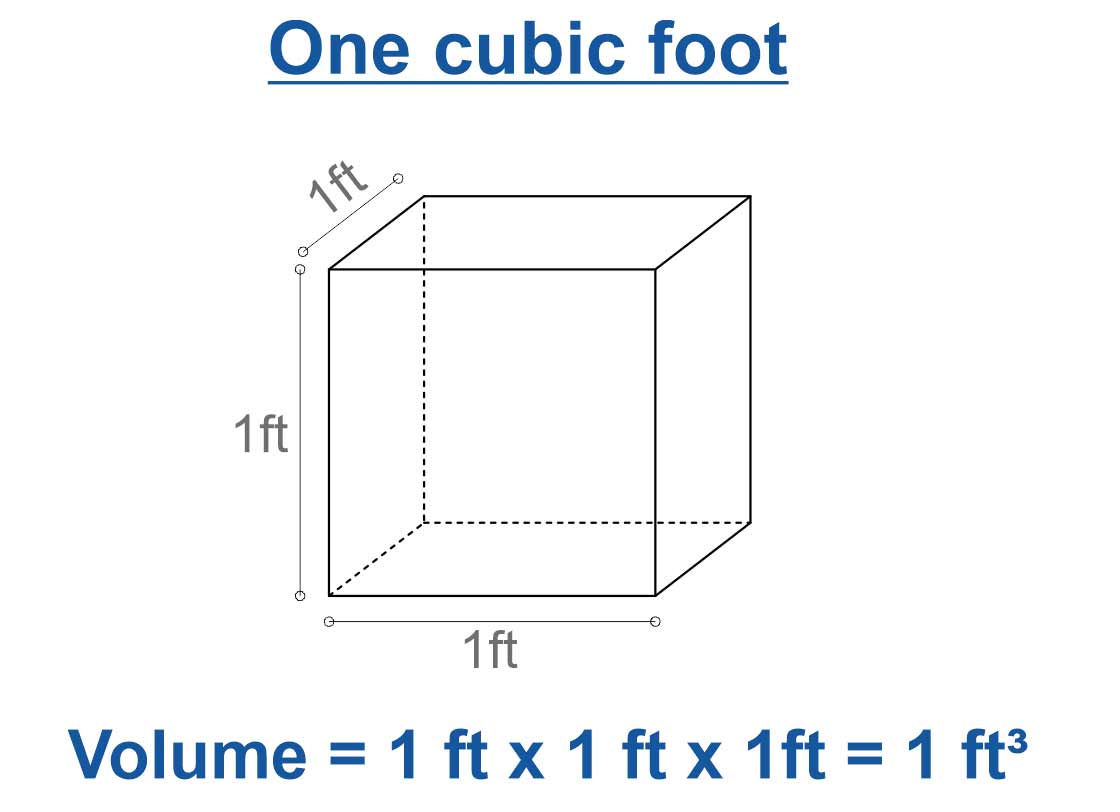A unit of volume that denotes the volume of space engaged by a cube with sides that measure one foot in length is a cubic foot. It is commonly abbreviated as “ft³” or “cu ft.”
The term “cubic” refers to the three-dimensional shape, while “feet” represents the unit of length used in the measurement.
However, the modern system of measurement including the use of cubic feet is largely based on the development of the imperial system primarily used in the United States.
In the 19th century, the British Weights and Measures Act of 1824 formalized the use of the imperial system and its units of measurement including the cubic foot.
The cubic foot was well-defined as the volume occupied by a cube calculating one foot (12 inches) on each side. It became a widely used unit particularly in construction, architecture, and engineering, for measuring the volume of buildings, rooms, containers, and other objects.
In this article, we will discuss the basic definition of cubic feet, the notation of cubic feet, how to convert cubic inches into cubic feet, and the importance of cubic feet in engineering detail.
Cubic foot
Cubic foot is a unit of volume measurement used to quantify the amount of three-dimensional space occupied by an object or a region. It is abbreviated as “ft³” or “cu ft.”
The term “cubic” refers to the three-dimensional shape, while “feet” represents the unit of length used in the measurement. The volume that a cylindrical object with sides that are one foot (12 inches) long takes up is known as a cubic foot.

Notation of cubic feet
The notation for cubic feet is “ft³” or “cu ft.” The symbol “ft” represents the unit of length which is feet and the superscript “³” indicates that the unit is being cubed representing the three-dimensional volume measurement.
Examples
Here are a few examples of how this notation is used:
- A container with a volume of 5 cubic feet would be written as 5 ft³ or 5 cu ft.
- If a room has a volume of 800 cubic feet, it would be represented as 800 ft³ or 800 cu ft.
- Let’s say you have a box with dimensions of 2 feet in length, 3 feet in width, and 4 feet in height. The volume of the box would be calculated as 2 ft × 3 ft × 4 ft = 24 ft³ or 24 cu ft.
- If you are shipping goods and the total volume of the shipment is 10,000 cubic feet, it would be denoted as 10,000 ft³ or 10,000 cu ft.
How to convert cubic inches into cubic feet?
The below table shows the cubic inches convert into cubic feet as follows
| Cubic inches | Cubic feet |
| 1 in3 | 0.000579 ft3 |
| 10 in3 | 0.005787 ft3 |
| 50 in3 | 0.028935 ft3 |
| 100 in3 | 0.05787 ft3 |
| 500 in3 | 0.289352 ft3 |
| 1000 in3 | 0.578704 ft3 |
| 5000 in3 | 2.8935 ft3 |
Importance of cubic feet in Engineering
The importance of cubic feet in engineering can be seen in several applications:
Space Planning and Design
Architects and engineers often need to determine the volume of a room, building, or structure to optimize space utilization plan HVAC (Heating, Ventilation, and Air Conditioning) systems, or calculate material requirements. Cubic feet provide a convenient measurement for these purposes.
Fluid Mechanics
In fluid dynamics, cubic feet are used to quantify the volume of fluids such as water, oil, or gas, in tanks, pipelines, or other systems. Engineers trust cubic feet to calculate flow rates, pressure drops, and design capacities of fluid handling equipment.
Structural Engineering
Cubic feet are relevant in structural engineering to assess the capacity and load-bearing capabilities of structures. It is used to determine the volume of materials like concrete, steel, or timber compulsory for building developments.
Transportation and Logistics
Cubic feet play a crucial role in determining the cargo capacity of vehicles such as trucks, ships, or airplanes. It helps optimize loading and unloading processes as well as estimate shipping costs based on volume.
How to find cubic feet?
You have to take the product of length, width, and height/depth of any object to find the cubic feet of any object. In other words, take the product of length, width, and height/depth of any object to find its volume in cubic feet.
Example 1:
A storage container measures 4 feet in length, 7 feet in width, and 2 feet in height. Find its volume in cubic feet
Solution:
Step 1:
First of all, identify the variables:
Length (L) = 4 feet
Width (W) = 7 feet
Height (H) = 2 feet
Step 2:
Multiplying the length, width, and height of a rectangle cylinder yields the volume. The following is the method:
Volume = L * W * H
Step 3:
Adapt the formula by substituting the values for length, width, and height.
Volume = 4 ft x 7 ft x 2 ft
Step 4:
Multiply the values together:
Volume = 56 cubic feet
Step 5:
So, volume = 72 cubic feet
Example 2:
What is the cubic foot volume? If a room finds 8 feet by 10 feet by 5 feet.
Solution:
Step 1:
First of all, identify the variables:
Length (L) = 8 feet
Width (W) = 10 feet
Height (H) = 5 feet
Step 2:
Multiplying the room’s length, breadth, and height yields the volume of a rectangle space. Our formula is as follows:
Volume = L * W * H
Step 3:
Adapt the formula by substituting the values for length, width, and height.
Volume = 8 feet * 10 feet * 5 feet
Step 4:
Multiply the values together:
Volume = 400 cubic feet
Step 5:
So, volume = 400 cubic feet.
Conclusion
In this article, we have discussed the basic definition of cubic feet, the notation of cubic feet, how to convert cubic inches into cubic feet, and the importance of cubic feet in engineering in detail. Also, cubic feet explain with the help of examples.




What a great post! Your points are well-articulated and backed by solid research. Impressive work!
Your post was both educational and entertaining. A rare combination that you’ve mastered beautifully!